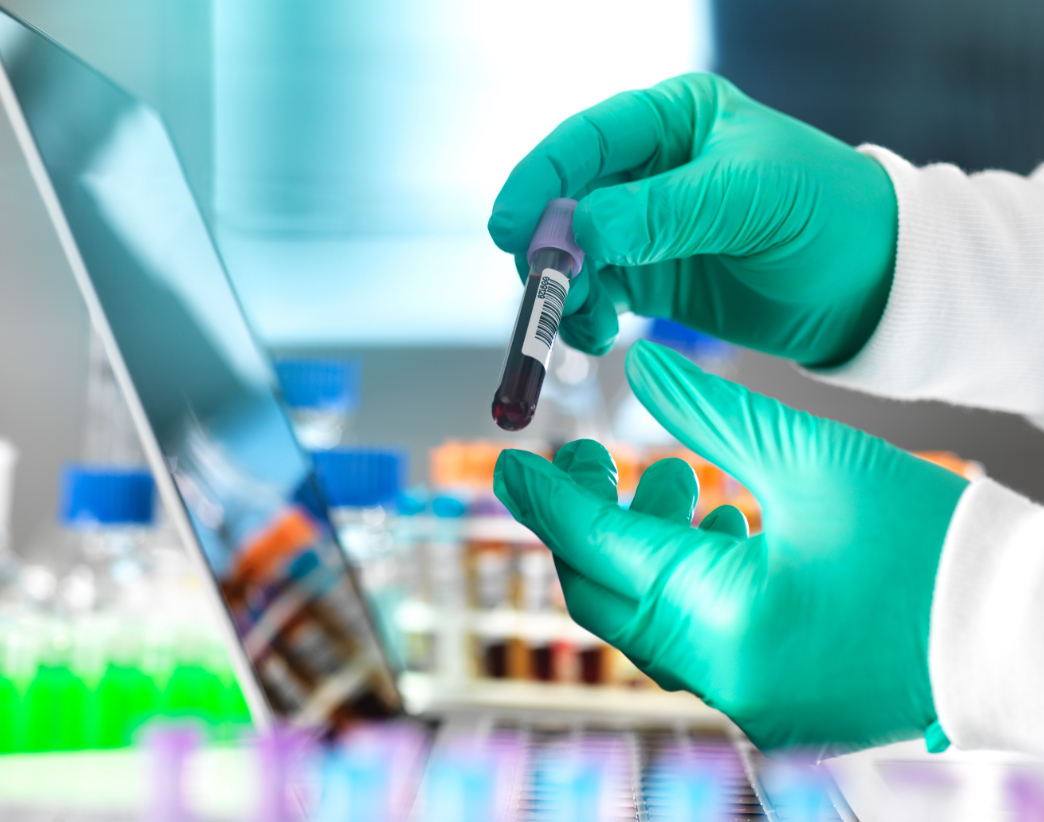Quest makes it easier to test your female patients for infections
Left untreated, STIs and other infections can have devastating consequences for women and their reproductive health. It’s for her protection.


The insights you need to provide the best care for your patients

Chlamydia trachomatis/Neisseria gonorrhoeae
Chlamydia trachomatis and Neisseria gonorrheae are the 2 most commonly reported notifiable diseases in the United States. They are among the most prevalent of all STDs, and since 1994, have comprised the largest proportion of all STDs reported to Centers for Disease Control and Prevention.1
In 2018, there were 1,758,668 cases of Chlamydia trachomatis and 583,405 cases of Neisseria gonorrhoeae reported.2
Left untreated, chlamydia and gonorrhea may affect the upper reproductive tract, resulting in pelvic inflammatory disease (PID).3 PID can have devastating consequences for women, including:
- Infertility3
- Life-threatening ectopic pregnancy,3 the leading obstetrical cause of maternal mortality in the first trimester4,5
- Chronic pelvic pain3

Trichomoniasis vaginalis
Trichomoniasis (trich) affects more than 3.7 million people across the country, making it the most prevalent nonviral sexually transmitted infection in the US.6 More than 11% of women 40 years of age and older are infected with trich. Rates are even higher in women with a history of STIs—with 3 in 10 testing positive for the infection.
Trich can live in your patient’s system for months to years if left untreated.
Most cases of trichomoniasis are asymptomatic. Without symptoms, patients are not always tested, so they remain contagious and can pass the infection to others.6 When symptoms do occur, they typically include:
- Cervicitis, urethritis, vaginitis
- Vaginal discharge that may be malodorous, yellow-green, with or without vulvar irritation

Mycoplasma genitalium
Mycoplasma genitalium is a sexually transmitted pathogen that causes inflammation of the urethra (urethritis) and cervix (cervicitis) and is associated with female pelvic inflammatory disease (PID) and other adverse sexual and reproductive health outcomes. The clinical presentation of Mycoplasma genitalium is similar to many other STIs, such as chlamydia, gonorrhea, and trichomoniasis.7
- Mycoplasma genitalium is detected in 10%-30% of women with clinical cervicitis8
- Identified in up to 22% of PID cases8
- Infected patients are 2 times more likely to acquire HIV9
Mycoplasma genitalium infections may go unrecognized, either because infected individuals are asymptomatic or the symptoms are the same as those associated with other infections of the urogenital tract (eg, chlamydia, gonorrhea, or trichomoniasis). Accurate identification of a patient’s Mycoplasma genitalium infection status is critical for effective patient treatment for reproductive disorders.
Gram stain and culture are not clinically feasible methods of detection for Mycoplasma genitalium due to the pathogen’s lack of cell wall10 and fastidious nature.8 NAATs are preferred for detecting Mycoplasma genitalium because this pathogen cannot be visualized under a microscope and is prohibitively difficult to culture.11


Vaginitis
Vaginitis is the most common gynecologic diagnosis in the primary care setting, affecting 1 in 3 women in their lifetime, but diagnosing its cause can be challenging.
The 3 diseases most frequently associated with vaginitis are bacterial vaginosis (BV), caused by an overgrowth of bacteria including Gardnerella vaginalis and anaerobes; vaginal trichomoniasis (TV), caused by Trichomonas vaginalis; and vulvovaginal candidiasis, usually caused by Candida albicans.
Cervicitis can also sometimes cause a vaginal discharge, but because the diagnostic tests and treatments for cervicitis are different from those for vaginitis, it is important to differentiate these conditions.12


Cervicitis
Cervicitis is an inflammation of the cervix, the lower, narrow end of the uterus that opens into the vagina. Cervicitis can result from common sexually transmitted infections (STIs), including Mycoplasma genitalium, gonorrhea, chlamydia, trichomoniasis, and genital herpes. Possible symptoms of cervicitis include bleeding between menstrual periods, pain with intercourse or during a cervical exam, and abnormal vaginal discharge. However, it’s also possible to have cervicitis and not experience any signs or symptoms.

Pelvic inflammatory disease
Pelvic inflammatory disease (PID) is an infection of the female reproductive organs and often due to sexually transmitted infections including Chlamydia trachomatis, Neisseria gonorrhoeae, Trichomonas vaginalis, and/or Mycoplasma genitalium.
Symptoms may include pain in the lower abdomen and pelvis, heavy vaginal discharge with an unpleasant odor, abnormal vaginal bleeding, and pain during intercourse.
Herpes
Genital herpes is common in the United States. More than 1 out of every 6 people aged 14 to 49 years have genital herpes.13
Genital herpes is caused by 2 types of viruses: herpes simplex virus type 1 (HSV-1) and herpes simplex virus type 2 (HSV-2). Oral herpes is usually caused by HSV-1 and can result in cold sores or fever blisters on or around the mouth. Oral herpes caused by HSV-1 can be spread from the mouth to the genitals through oral sex.
A comprehensive test menu for your female patients
Our comprehensive menu provides the tests you need for diagnosing patients who present with symptoms, so you can deliver the highest quality of care—from testing through follow-up.
Laboratory Screenings
Test name
Test code
CPT Codea
LABORATORY SCREENING
Chlamydia
TEST NAME
Chlamydia trachomatis RNA, TMA, Urogenital
TEST CODE
11361
CPT Codea
87491
TEST NAME
Chlamydia trachomatis RNA, TMA, Rectal
TEST CODE
16505
CPT Codea
87491
TEST NAME
Chlamydia trachomatis RNA, TMA, Throat
TEST CODE
70048
CPT Codea
87491
LABORATORY SCREENING
Gonorrhea
TEST NAME
Neisseria gonorrhoeae RNA, TMA, Urogenital
TEST CODE
11362
CPT Codea
87591
TEST NAME
Neisseria gonorrhoeae RNA, TMA, Rectal
TEST CODE
16504
CPT Codea
87591
TEST NAME
Neisseria gonorrhoeae RNA, TMA, Throat
TEST CODE
70049
CPT Codea
87591
LABORATORY SCREENING
Chlamydia and Gonorrhea
TEST NAME
Chlamydia/Neisseria gonorrhoeae RNA, TMA, Urogenital
TEST CODE
11363
CPT Codea
87491, 87591
TEST NAME
Chlamydia/Neisseria gonorrhoeae RNA, TMA, Rectal
TEST CODE
16506
CPT Codea
87491, 87591
TEST NAME
Chlamydia/Neisseria gonorrhoeae RNA, TMA, Throat
TEST CODE
70051
CPT Codea
87491, 87591
LABORATORY SCREENING
Trichomonas vaginalis
TEST NAME
SureSwab®, Trichomonas vaginalis RNA, Qualitative, TMA
TEST CODE
19550
CPT Codea
87661
TEST NAME
Trichomonas vaginalis RNA, Qualitative, TMA, Pap Vial
TEST CODE
90521
CPT Codea
87661
LABORATORY SCREENING
Chlamydia, Gonorrhea and Trichomonas vaginalis
TEST NAME
SureSwab®, CT/NG, T vaginalis
TEST CODE
16492
CPT Codea
87491, 87591, 87661
TEST NAME
Chlamydia/N. gonorrhoeae and T. vaginalis RNA, Qualitative, TMA, Pap Vial
TEST CODE
91448
CPT Codea
87491, 87591, 87661
LABORATORY SCREENING
Mycoplasma genitalium
TEST NAME
Mycoplasma genitalium, rRNA, TMA
TEST CODE
91475
CPT Codea
87563
LABORATORY SCREENING
Herpes simplex virus 1/2 for lesions
TEST NAME
SureSwab®, Herpes Simplex Virus, Type 1 and 2 mRNA,TMA
TEST CODE
90570
CPT Codea
87529 (x2)
LABORATORY SCREENING
Herpes simplex virus 1/2 serology
TEST NAME
Herpes Simplex Virus 1 and 2 (IgG), with Reflex to HSV-2 Inhibition
TEST CODE
17169
CPT Codea
86695, 86696
LABORATORY SCREENING
Cervicitis
TEST NAME
Sexually-Transmitted Infections (STIs) Cervicitis Panel
TEST CODE
36962
CPT Codea
87491, 87591, 87661, 87563
LABORATORY SCREENING
Pelvic inflammatory disease (PID)
TEST NAME
Sexually-Transmitted Infections (STIs) Pelvic Inflammatory Disease (PID) Panel
TEST CODE
36965
CPT Codea
87491, 87591, 87661, 87563
LABORATORY SCREENING
Genital Lesion
TEST NAME
Sexually-Transmitted Infections (STIs) Genital Lesion Panel
TEST CODE
38286
CPT Codea
87529 (x2), 87798
LABORATORY SCREENING
Syphilis lesion
TEST NAME
Treponema pallidum DNA, Qualitative Real-Time PCR
TEST CODE
16595
CPT Codea
87798
LABORATORY SCREENING
Syphilis serology
TEST NAME
RPR (Diagnosis) with Reflex to Titer and Confirmatory Testing
TEST CODE
36126
CPT Codea
86592
LABORATORY SCREENING
Hepatitis C
TEST NAME
Hepatitis C Antibody with Reflex to HCV, RNA, Quantitative, Real-Time PCR
TEST CODE
8472
CPT Codea
86803
LABORATORY SCREENING
HPV
TEST NAME
HPV mRNA E6/E7, Rectal
TEST CODE
91932
CPT Codea
87624
TEST NAME
HPV mRNA E6/E7, Rectal with Reflex to Genotypes, 16, 18/45
TEST CODE
92810
CPT Codea
87624
TEST NAME
HPV Genotypes 16, 18/45, Anal-Rectal
TEST CODE
92807
CPT Codea
87625
LABORATORY SCREENING
Cytology, non-gynecological
TEST NAME
Cytology, Non-Gynecological, Fluid, Washings, Brushings or FNA
TEST CODE
10676
CPT Codea
88104, 88108, 88112, 88160, 88161, 88162, 87207, 88172, 88173, 88305
LABORATORY SCREENING
Vaginosis/vaginitis
TEST NAME
SureSwab®, Bacterial Vaginosis DNA, Quantitative, Real-Time PCR
TEST CODE
10016
CPT Codea
81513
TEST NAME
SureSwab® Advanced Candida Vaginitis (CV), TMA
TEST CODE
10121
CPT Codea
87481*2
TEST NAME
SureSwab Advanced Candida Vaginitis (CV)/Trichomonas vaginalis (TV), TMA
TEST CODE
10029
CPT Codea
87481*2 87661
TEST NAME
SureSwab® Advanced Bacterial Vaginosis (BV), CT/NG, TMA
TEST CODE
10123
CPT Codea
81513, 87491, 87591
TEST NAME
SureSwab® Advanced Vaginitis, TMA
TEST CODE
10119
CPT Codea
81513 87481*2 87661
TEST NAME
SureSwab® Advanced Vaginitis Plus, TMA
TEST CODE
10120
CPT Codea
81513 87481*2 87661 87491 87591
Components of panels can be ordered separately.
Test codes may vary by location. Please contact your local laboratory for more information.
a The CPT® codes provided are based on American Medical Association guidelines an are for informational purposes only. CPT coding is the sole responsibility of the billing party. Please direct any questions regarding coding to the payer being billed.
References:
- CDC. Sexually transmitted disease surveillance 2018. Chlamydia. Updated September 30, 2019. Accessed November 19, 2020. https://www.cdc.gov/std/stats18/chlamydia.htm
- CDC. Sexually transmitted diseases — reported cases and rates of reported cases, United States, 1941–2018. Updated August 20, 2019. Accessed November 19, 2020. https://www.cdc.gov/std/stats18/tables/1.htm
- Farley TA, Cohen DA, Elkins W. Asymptomatic sexually transmitted diseases: the case for screening. Prev Med. 2003;36(4):502-509. doi:10.1016/s0091-7435(02)00058-0
- Creanga AA, Shapiro-Mendoza CK, Bish CL, et al. Trends in ectopic pregnancy mortality in the United States: 1980–2007. Obstet Gynecol. 2011;117(4):837-843. doi:10.1097/AOG.0b013e3182113c10
- Tenore JL. Ectopic pregnancy. Am Fam Physician. 2000;61(4):1080-1088.
- CDC. 2015 Sexually Transmitted Diseases Treatment Guidelines. Trichomoniasis. Updated June 4, 2015. Accessed November 5, 2015. http://www.cdc.gov/std/tg2015/trichomoniasis.htm
- Falk L, Fredlund H, Jensen JS. Signs and symptoms of urethritis and cervicitis among women with or without Mycoplasma genitalium or Chlamydia trachomatis infection. Sex Transm Infect. 2005;81(1):73-78. doi:10.1136/sti.2004.010439
- CDC. 2015 Sexually Transmitted Diseases Treatment Guidelines. Emerging issues. Updated June 4, 2015. Accessed November 20, 2019. https://www.cdc.gov/std/tg2015/emerging.htm
- Napierala Mavedzenge S, Weiss HA. Association of Mycoplasma genitalium and HIV infection: a systematic review and meta-analysis. AIDS. 2009;23(5):611-620. doi:10.1097/QAD.0b013e328323da3e
- Egan ME, Lipsky MS. Diagnosis of vaginitis. Am Fam Physician. 2000;62(5):1095-1104.
- Workowski KA, Bolan GA, Centers for Disease Control and Prevention. Sexually transmitted diseases treatment guidelines, 2015. MMWR Recomm Rep. 2015;64(RR-03):1-137.
- CDC. 2015 Sexually Transmitted Diseases Treatment Guidelines. Diseases characterized by vaginal discharge. Updated June 4, 2015. Accessed November 21, 2020. https://www.cdc.gov/std/tg2015/vaginal-discharge.htm
- CDC. Genital herpes – CDC fact sheet. Updated August 28, 2017. Accessed November 20, 2020. https://www.cdc.gov/std/herpes/stdfact-herpes.htm



